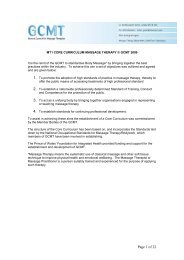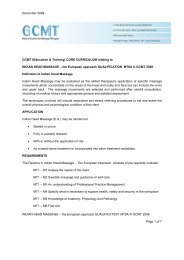Create successful ePaper yourself
Turn your PDF publications into a flip-book with our unique Google optimized e-Paper software.
detecting 9/3/06 14:16 Page 1<br />
Other signs of skin cancer<br />
• a new growth or sore that won’t heal<br />
• a spot, mole or sore that itches or hurts<br />
• a mole or growth that bleeds, crusts or scabs<br />
Any change in a mole, freckle or normal patch of skin<br />
that occurs quickly, over weeks or months, should be<br />
taken seriously.<br />
Does skin cancer spread?<br />
Melanoma and some other skin cancers will spread<br />
to other parts of the body if left untreated. Some skin<br />
cancers spread more quickly than others. It is<br />
essential to see your doctor as soon as you notice<br />
these changes.<br />
What will happen at the<br />
doctor’s?<br />
If your doctor has any concerns you will be referred<br />
to a hospital specialist. If your specialist thinks you<br />
might have skin cancer it will be removed in a simple<br />
operation under local anaesthetic.The skin will then<br />
be examined. If it is skin cancer you may be given<br />
treatment and invited to attend regular check-ups.<br />
Who is most at risk?<br />
Everyone should check their skin for changes but<br />
some people are more likely than others to get skin<br />
cancer. People with fair skin, lots of moles or freckles,<br />
or a family history of skin cancer are most at risk.<br />
Further information<br />
Visit <strong>Cancer</strong> Research UK’s SunSmart website<br />
www.sunsmart.org.uk<br />
For more about cancer visit our patient information<br />
website www.cancerhelp.org.uk click on 'specific<br />
cancers' then 'melanoma skin cancer' or 'skin cancer<br />
(not melanoma)’.<br />
If you want to talk in confidence about cancer, call<br />
our information nurses. Direct line 020 7061 8355<br />
or freephone 0800 CANCER, that is<br />
0800 226 237<br />
For more about how to be SunSmart, please see our<br />
‘Preventing skin cancer’ leaflet. Order copies of this<br />
and other cancer awareness leaflets online at<br />
www.cancerresearchuk.org/leaflets email<br />
publications@cancer.org.uk or call 020 7061 8333<br />
About <strong>Cancer</strong> Research UK<br />
<strong>Cancer</strong> Research UK is the leading charity dedicated<br />
to research on the causes, treatment and prevention<br />
of cancer. If you would like to support our work<br />
please call 020 7121 6699 or visit our website.<br />
www.cancerresearchuk.org<br />
www.cancerhelp.org.uk<br />
March 2006<br />
<strong>Cancer</strong> Research UK registered charity no.1089464<br />
detecting<br />
skin<br />
cancer<br />
how to spot the changes early
detecting 9/3/06 14:16 Page 2<br />
<strong>Skin</strong> cancer facts<br />
Where can skin cancer start?<br />
The ABCD rule<br />
<strong>Skin</strong> cancer is very common in the UK.<br />
Finding skin cancer early saves lives, so it is<br />
very important to know the signs.<br />
<strong>Skin</strong> cancer often first appears as a change in<br />
a mole or a patch of normal skin. If you<br />
notice a change that happens over weeks or<br />
months you should act without delay. Most<br />
changes are not caused by cancer, but do<br />
need to be checked out by a doctor.<br />
The most common sites for melanoma are the leg in<br />
women, the back in men and the face in older people.<br />
But a melanoma can grow anywhere, sometimes on<br />
the sole of the foot, or on the buttocks.<br />
Other types of skin cancer often affect areas that catch<br />
the most sun such as the head, neck, shoulders or<br />
arms.<br />
What are the signs of skin<br />
cancer?<br />
Asymmetry<br />
The two halves of a<br />
melanoma may not<br />
look the same<br />
Border<br />
Edges of a melanoma<br />
may be irregular,<br />
blurred or jagged<br />
15mm<br />
10mm<br />
The most serious type of skin cancer is called<br />
malignant melanoma also known as melanoma.<br />
Other types of skin cancer are called nonmelanoma.<br />
Non-melanomas are by far the most<br />
common skin cancers.<br />
Most of the information in this leaflet is about<br />
melanoma. When found early and treated quickly,<br />
this serious disease can be cured.The leaflet also<br />
provides information about other types of skin<br />
cancer. They are much less dangerous than<br />
melanoma but still need early treatment.<br />
You may have some moles or dark patches on your<br />
skin that are flat or slightly raised. Usually these will<br />
remain harmless all your life. Show your doctor any<br />
moles or patches of normal skin that change in size,<br />
shape or colour over weeks or months.<br />
Check your skin regularly for changes.This is especially<br />
important if you are fair skinned with lots of moles or<br />
freckles.The ABCD rule can help you remember what<br />
to look out for. If you notice any of the ABCD signs,<br />
see your doctor without delay.<br />
Colour<br />
The colour of a<br />
melanoma may be<br />
uneven, with more<br />
than one shade<br />
10mm<br />
30mm<br />
What causes skin cancer?<br />
The main cause of skin cancer is too much sun.<br />
Sunburn can double the risk of skin cancer. Lots<br />
of sun over your lifetime also increases your risk<br />
of certain skin cancers.<br />
Diameter<br />
Many melanomas are<br />
at least 6mm in<br />
diameter, the size of a<br />
pencil eraser




